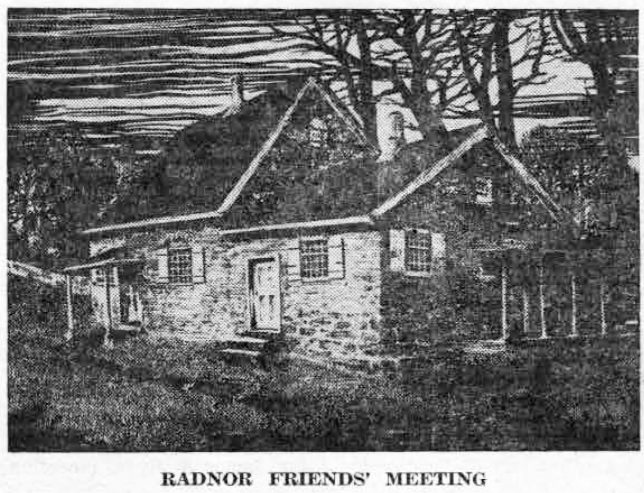 A description of the founding of St. Mary’s Church, in 1890, was presented in this column, September 28, as told in the book, “Rural Pennsylvania.” This interesting volume, published in 1897 by George W. Jacobs and Company, Philadelphia, contains brief articles about old churches and homes in the vicinity of Philadelphia, many in the Wayne area. The book was compiled by the Rev. S.F. Hotchkiss, of St. Luke’s Church, Philadelphia, from articles written by authors of that period. Today, we are quoting Joseph F. Doran, on the old Radnor Friends’ Meeting, which should be of interest to readers, as a supplement to a series on the meeting house which appeared in this column previously.
A description of the founding of St. Mary’s Church, in 1890, was presented in this column, September 28, as told in the book, “Rural Pennsylvania.” This interesting volume, published in 1897 by George W. Jacobs and Company, Philadelphia, contains brief articles about old churches and homes in the vicinity of Philadelphia, many in the Wayne area. The book was compiled by the Rev. S.F. Hotchkiss, of St. Luke’s Church, Philadelphia, from articles written by authors of that period. Today, we are quoting Joseph F. Doran, on the old Radnor Friends’ Meeting, which should be of interest to readers, as a supplement to a series on the meeting house which appeared in this column previously.
“Probably the most interesting historical landmark in Radnor township is the old Radnor Meeting House, Old Conestoga and Old Radnor roads, Ithan. Built about 1717, it is closely identified with local history and with families of early settlers. The Radnor, Haverford and Merion Meetings were, as Glenn says in ‘Merion in the Welsh Tract’…. practically one and the same meeting, although they separately controlled in turn yearly, monthly and preparatory meetings of Friends. The records of these meetings, for a number of years, were not entirely separated, which is frequently confusing. These records are historically rich.
“During the Valley Forge encampment, the meeting house was used as officers’ quarters and a hospital for the American Army. The records of the Society show that it was deprived of the use of the meeting-place because of military occupancy and it required considerable repair to recondition it for meetings, which were not resumed until 1780.
“The peaceful quiet of the Society was broken when members entered military service in defense of their country during the Revolution. The records of the monthly meetings in Delaware county show that 110 young men were disowned by the Society for bearing arms.
“Isaac Warner, Colonel of the 7th battalion of Philadelphia County Militia, and Algernon Roberts, Lieut., Colonel of the same group, who married Warner’s daughter, Tacy, in 1781, at Old Swedes Church, Philadelphia, were among those disowned. The action in their cases is thus recorded in the minutes of , Radnor Meeting, 10th, 5th month, 1176, p. 456: ‘The cases of Isaac Warner, Algernon Roberts, Isaac Kite, Jr., and Richard Thomas, coming under consideration and it appearing they persist in the practice of bearing arms and it is the sense and judgment of this meeting that they have publicly denounced our peaceful principles and can not be deemed members of our religious society, whilst continuing in the practice, but disown them until they, through circumspect walking, make this meeting such satisfaction as the nature of their case requires, which that, through the assistance of divine grace, they may be enabled to do what we desire.”
“This is an illustration of the trials of those days which will yet furnish the historian and the novelist with much material. Many are the descendants in Philadelphia and its vicinity of Isaac Warner and Algernon Roberts, but few have returned to the membership their forefathers had in the Society of Friends…”
This quaintly phrased, reference to the lovely old church building, still standing in Ithan, tells something of its early vicissitudes in the days when 110 of its young men, and others in nearby Quaker Meetings, were disowned by the Society for bearing arms in the American Revolution.
